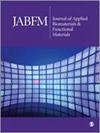Effects of different antiviral mouthwashes on the surface roughness, hardness, and color stability of composite CAD/CAM materials
IF 3.1
4区 医学
Q2 BIOPHYSICS
Journal of Applied Biomaterials & Functional Materials
Pub Date : 2024-04-28
DOI:10.1177/22808000241248886
引用次数: 0
Abstract
Objective:To evaluate the effect of COVID-19 preventive mouthwashes on the surface hardness, surface roughness (Ra), and color change (ΔE) of three different polymer-based composite CAD/CAM materials (Vita Enamic (ENA), Grandio Block (GB), Lava Ultimate (LU)).Methods:A total of 100 rectangular-shaped specimens with dimensions of 2 mm × 7 mm × 12 mm were obtained by sectioning three different CAD/CAM blocks and randomly divided into five subgroups according to the 30 days of mouthwash immersion protocol as follows: Control: artificial saliva, PVP-I: 1% povidone-iodine, HP: 1.5% hydrogen peroxide, CPC: mouthwash containing 0.075% cetylpyridinium chloride, EO: mouthwash containing essential oils. Microhardness, Ra, and ΔE values were measured at baseline and after 30 days of immersion protocols. Data were analyzed using the Wald Chi-square, two-way ANOVA, and post hoc Tukey tests.Results:The independent factors (materials and solutions) significantly influenced the microhardness and color ( p < 0.001). Ra of the materials was not affected by any of the mouthwashes ( p > 0.05). The microhardness and color of each material varied significantly after immersion in PvP-I and HP ( p < 0.05). The highest percentage change in microhardness, Ra, and ΔE was found in LU immersed in PvP-I and HP mouthwashes, while the lowest change was found in ENA groups ( p < 0.05).Conclusion:Within the limitations of this study, it was found that the surface hardness and color of tested polymer-based composite CAD/CAM materials are susceptible to degradation and change after 30 days of immersion in 1% PvP-I and 1.5% HP mouthwashes.不同抗病毒漱口水对 CAD/CAM 复合材料表面粗糙度、硬度和颜色稳定性的影响
目的:评估 COVID-19 预防性漱口水对三种不同聚合物基复合 CAD/CAM 材料(Vita Enamic (ENA)、Grandio Block (GB)、Lava Ultimate (LU))的表面硬度、表面粗糙度 (Ra) 和颜色变化 (ΔE)的影响。方法:通过对三种不同的 CAD/CAM 块进行切片,共获得 100 个尺寸为 2 mm × 7 mm × 12 mm 的矩形试样,并按照漱口水浸泡 30 天的方案随机分为以下 5 个亚组:对照组:人工唾液;PVP-I:1% 聚维酮碘;HP:1.5% 过氧化氢;CPC:含 0.075% 氯化十六烷基吡啶的漱口水;EO:含精油的漱口水。微硬度、Ra 和 ΔE 值分别在基线和浸泡 30 天后测量。结果:独立因素(材料和溶液)对显微硬度和颜色有显著影响(p < 0.001)。材料的 Ra 值不受任何漱口水的影响(p > 0.05)。在 PvP-I 和 HP 中浸泡后,每种材料的显微硬度和颜色都有显著变化(p < 0.05)。结论:在本研究的局限性范围内,研究发现在 1%的 PvP-I 和 1.5% 的 HP 漱口水中浸泡 30 天后,测试的聚合物基复合 CAD/CAM 材料的表面硬度和颜色容易发生降解和变化。
本文章由计算机程序翻译,如有差异,请以英文原文为准。
求助全文
约1分钟内获得全文
求助全文
来源期刊

Journal of Applied Biomaterials & Functional Materials
BIOPHYSICS-ENGINEERING, BIOMEDICAL
CiteScore
4.40
自引率
4.00%
发文量
36
审稿时长
>12 weeks
期刊介绍:
The Journal of Applied Biomaterials & Functional Materials (JABFM) is an open access, peer-reviewed, international journal considering the publication of original contributions, reviews and editorials dealing with clinical and laboratory investigations in the fast growing field of biomaterial sciences and functional materials.
The areas covered by the journal will include:
• Biomaterials / Materials for biomedical applications
• Functional materials
• Hybrid and composite materials
• Soft materials
• Hydrogels
• Nanomaterials
• Gene delivery
• Nonodevices
• Metamaterials
• Active coatings
• Surface functionalization
• Tissue engineering
• Cell delivery/cell encapsulation systems
• 3D printing materials
• Material characterization
• Biomechanics
 求助内容:
求助内容: 应助结果提醒方式:
应助结果提醒方式:


